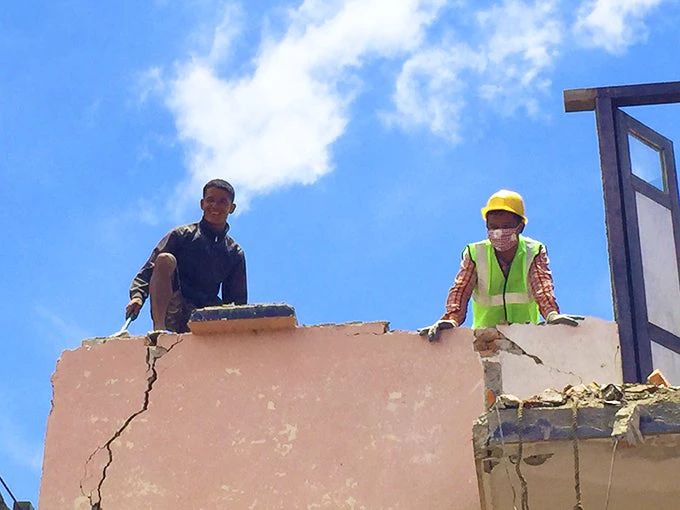
It has been exactly three months since the Nepal earthquake first struck and one month since the donor conference. The humanitarian phase is nearing its end, the international presence is starting to move onto the next crisis, and high level international dignitaries have now returned to their capitals. The earthquake is no longer making headline news and the government is getting back to business as usual, albeit with the huge challenge of rebuilding.
Now is time to take stock of the events from the past three months. During a crisis, there is no time for those involved to look back at what has been accomplished. What matters is the next immediate action and challenge to overcome. Last week, in the Bank headquarters, our management and some members of the earthquake response team presented the progress achieved thus far to an overcrowded room. This was my first opportunity to reflect on the disaster and I was almost overcome with emotion. Be they senior government officials, the Bank’s country office team, first- emergency responders, or Nepalis, it is difficult to articulate just what folks have overcome in Nepal.

Watch Video of Announcement Credit: Yann Doignon / World Bank
While faults can be found in any disaster response, the Government of Nepal has done an excellent job responding to this event. The Government’s strong leadership ensured that a high-quality Post Disaster Needs Assessment (PDNA) was accomplished in a short timeframe. The credibility of the PNDA and the professionalism exhibited at the donor conference were instrumental in raising $4.4 billion, of which, $2.7 billion was new money. Government’s leadership has also been critical in the strong progress that has been achieved thus far in the design of the Government’s housing reconstruction program. This program is the cornerstone to the overall recovery effort, giver than over half of the damages and losses were to private homes in remote places. Decision makers in key government agencies have been bombarded with new information and ideas, and have been able to sift through the nuances to design a credible program that will deliver the necessary support in the coming years.
The response by Bank staff and our development partners has also been exemplary. Within our own organization, individuals have been working 12-15 hours a day for the past three months and many have reached far outside of their professional comfort zone to deliver results. Teams from many units, particularly our social protection team, have been partners in the response, along with multiple teams and individuals from the Global Facility for Disaster Reduction and Recovery (GFDRR), which made funds available and began working immediately after the first earthquake. In the disaster risk management community, it is relatively easy to fly into a disaster -affected area and respond; it is part of our job: we have safe places to stay, and our lives are not interrupted by the surrounding destruction. This is not the case for those in country offices as they work very long hours and deal with an unfamiliar subject area, and then have to go back to damaged homes and disrupted lives. This is hard and, to a person, our country office staff and emergency team members have responded with grace and fortitude.

The leadership and support from World Bank management has been critical to empower the disaster response team, support the government in moving forward ambitiously, and convene development partners around a vision for recovery. Often, post- disaster environments are filled with negativity and skepticism as to the success of an ambitious recovery program. It has been no different in Nepal. However, strong leadership from our management has delivered the confidence necessary and begun to turn critics into believers.
With the government, we are about to kickstart the housing recovery program. This is when the hard work begins. We are building off a strong foundation that has been laid over the past three months, and we are in a better position 3 months after the earthquake than in previous comparable disasters. We have a model of success to build from. Namely, the housing reconstruction program in Pakistan after the 2005 Kashmir earthquake, itself built on a successful model in Gujarat. Not only do we have a successful model, but many Nepalis were involved in the Pakistan program in particular. Therefore, we already have seismic resilient housing designs, a model to follow for implementation, and a track record of success in moving resources through bank accounts to support the owner driven reconstruction process.
Success will be defined by the speed at which the program moves, the strength of the grievance redress mechanism, the robustness of the governance measures in place to ensure transparency, and the technical assistance package to support owners in rebuilding. Success also depends on equality of outcome, with uniform policies for subsidies and support; the government has been effective thus far at ensuring such equity is embedded into program. The pieces are coming into place, but this will be a long and difficult effort that we are committed to implement over the five coming years.
The post-earthquake response has been effective thus far, the housing platform is coming together, and success is on the horizon. However, it will require continued dedication by the government and our development partners to ensure that we collectively deliver to the 9% of the population that is currently homeless.
For more information please visit: Fact Sheet: What the World Bank Group is doing in Nepal after the earthquakes


Join the Conversation